A Better Sense of Place
2015 October 23 (Fri)
Fall color
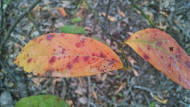
Woot! It's fall, the usual weird mix of warm, humid days and refreshing cool fronts. I decided a while back to make sure I have native plants with strong fall color. It's taking a while for things to mature, of course, but this is the first fall where there's a good hint of what's to come in the future.
2015 September 3 (Thu)
Late summer fruits and flowers
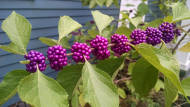
It's looking like the hot summer drought has ended here. As the sun is moving closer to equinox, temperatures are now only going up to about 92°F. Many plants are doing better after some rain showers last week gave them water to drink. We even had a pretty good cold front come through. Fall is coming, so I figured it's a good time to focus on all the fruit and flowers around the yard to make me feel like my efforts didn't all end in failure this summer.
2015 August 2 (Sun)
A hot, dry summer
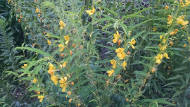
A lot of plants found themselves put on my "At Risk" list this weekend. With temperatures rising to 95-100°F every day for the past 3 weeks and little rain for most of that time, I've decided to adjust my preference for what I plant and where. I know it takes a couple years for many plants to establish, so I'm not giving up on the newly planted stuff. Those guys generally need regular watering under dry conditions, even if they're native. And pretty much everything in a pot needs regular watering because their roots have limited reach. Also, established plants can go somewhat dormant in the heat of the summer and then come back to life when the temperatures start to lower again in the fall. So taking all of this into account, I've made a list of stand-out individuals and a list of questionable individuals.
2015 June 29 (Mon)
Overgrown but not forgotten
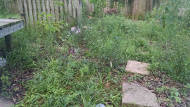
It has rained pretty consistently for the past month and a half. Not non-stop. Just frequently enough that the ground hasn't dried out. So the weeds are taking over. The St. Augustine grass is growing fast and tall and sending out stolons everywhere. Camphor, Chinese tallow, chamberbitter, low hop clover, and some crap exotic grasses are sprouting faster than I can remove them. There are a lot more dormant seeds in the yard than I expected. I can't imagine ever getting the yard to a state of natives consistently crowding out exotics.
2015 May 11 (Mon)
But have you seen the alley?
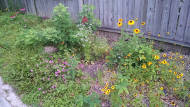
I forget where I learned this, but it is said that you don't remember where you hear things as much as the thing that you hear. I think of this lesson when I try to remember where I heard that growing native flowers and grasses is harder where the soil is fertile. I think this was in reference to prairie plants. When I see how things have gone so far all over my yard, I can agree. The back alley is amazing while the rain garden, Chicken Yard, and front yard are a bit lackluster.
2015 March 22 (Sun)
Spring weeds eternal
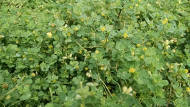
In my last post, I mentionned that the area I hoed and bordered between the sidewalk and the street is overtaken by exotic invasives. Yesterday, I was standing over it and wondering how to kill it back so that the seeds I sowed in October could sprout and see sunlight. But this morning, I was thinking that maybe it's a useful cover crop that I should live with until it dies from the heat. For this post, I've picked out seven plants, including the aforementionned exotic, that come back year after year to my yard in early spring. I think I've identified them all, and putting a name to a plant helps to understand where it's from and what it's doing. (Spoiler alert: only two are native.)
2015 March 15 (Sun)
It all wakes up
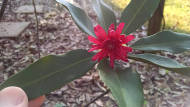
I've been trying to be patient all winter. I've sowed seed here and there (milkweed, lanceleaf coreopsis, blue mistflower, tickseed, rattlesnake master, coralbean, and little bluestem). I've planted new things (witchhazel, swamp sunflower, buttonbush, American beautyberry, crossvine, red mulberry, arrowwood viburnum, Turk's cap, and Eastern redbud). I've moved some others (ironweed and groundsel). I've dug things up and put them into pots (redcedars and pines). And I've waited, because this entire time, nothing has grown. At least above ground. As they say, the activity has all been below ground. But that's pretty boring because there's no proof that anything is happening.
2015 February 8 (Sun)
Winter update
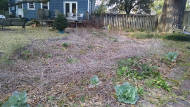
The rain garden has now been in existence for about 1.4 years. Way back in August and September 2013, I carved out a retention area and sowed the seed. The Chicken Yard was sown at the same time but without any land-sculpting. So how do they look now in their second mid-winter? (Or is it late winter?)


